- Joined
- Oct 9, 2007
- Messages
- 47,538 (7.47/day)
- Location
- Hyderabad, India
| System Name | RBMK-1000 |
|---|---|
| Processor | AMD Ryzen 7 5700G |
| Motherboard | ASUS ROG Strix B450-E Gaming |
| Cooling | DeepCool Gammax L240 V2 |
| Memory | 2x 8GB G.Skill Sniper X |
| Video Card(s) | Palit GeForce RTX 2080 SUPER GameRock |
| Storage | Western Digital Black NVMe 512GB |
| Display(s) | BenQ 1440p 60 Hz 27-inch |
| Case | Corsair Carbide 100R |
| Audio Device(s) | ASUS SupremeFX S1220A |
| Power Supply | Cooler Master MWE Gold 650W |
| Mouse | ASUS ROG Strix Impact |
| Keyboard | Gamdias Hermes E2 |
| Software | Windows 11 Pro |
Here are the first pictures of ASUS' premium DirectCu II graphics card designed around AMD's Radeon HD 7970 GPU. The design is based on giving the GPU a powerful cooling solution, backed by a custom-design PCB. Since its cooling solution spans across three expansion slots, one of the three expansion slot brackets is productively used to provide additional display connectivity. To begin with, the PCB uses a 10+1+1 ASUS Digi+ VRM that draws power from two 8-pin PCIe power connectors. It supports heavy overclocking, and provides several voltage tuning features.
A common metal heatsink spans along the length of the card, making contact with VRM and memory components. On top of this sits the DirectCu II heatsink. This heatsink uses a large aluminum fin-stack heatsink to which heat from the GPU is conveyed by six heat-pipes, which make direct contact with it. The heatsink itself isn't very thick, but what makes the card span across three slots are its two 100 mm fans. The GPU is clocked out of the box at 1000 MHz (vs. 925 MHz reference), and 5.60 GHz/1400 MHz actual memory (vs. 5.50 GHz/1375 MHz actual reference).
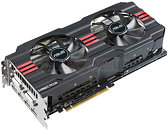
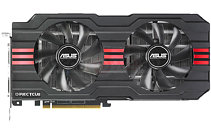
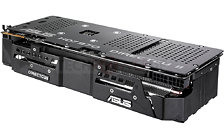
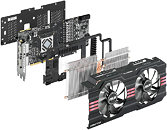
This card also features what is called "VGA Hotwire", which is a 2-pin cable, one end of which needs to be soldered onto the graphics card, the other is plugged into a special header on ROG Rampage IV series motherboards. This allows advanced users to eliminate the need for variable resistors and use the motherboard's voltage controller to tune come key voltage domains of the graphics card as if it were the motherboard's.

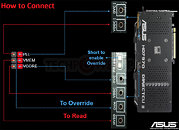
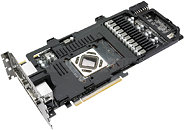
Display outputs include two dual-link DVI and four full-size DisplayPort 1.2 connectors. The card is 11 inches (27.94 cm) long, and we mentioned earlier spans across three expansion slots in your case. ASUS' previous-generation DirectCu II cards based on GeForce GTX 580/570 and Radeon HD 6970/6950 were just as big. Pricing information is not available.
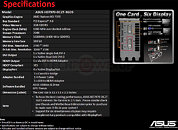
View at TechPowerUp Main Site
A common metal heatsink spans along the length of the card, making contact with VRM and memory components. On top of this sits the DirectCu II heatsink. This heatsink uses a large aluminum fin-stack heatsink to which heat from the GPU is conveyed by six heat-pipes, which make direct contact with it. The heatsink itself isn't very thick, but what makes the card span across three slots are its two 100 mm fans. The GPU is clocked out of the box at 1000 MHz (vs. 925 MHz reference), and 5.60 GHz/1400 MHz actual memory (vs. 5.50 GHz/1375 MHz actual reference).




This card also features what is called "VGA Hotwire", which is a 2-pin cable, one end of which needs to be soldered onto the graphics card, the other is plugged into a special header on ROG Rampage IV series motherboards. This allows advanced users to eliminate the need for variable resistors and use the motherboard's voltage controller to tune come key voltage domains of the graphics card as if it were the motherboard's.



Display outputs include two dual-link DVI and four full-size DisplayPort 1.2 connectors. The card is 11 inches (27.94 cm) long, and we mentioned earlier spans across three expansion slots in your case. ASUS' previous-generation DirectCu II cards based on GeForce GTX 580/570 and Radeon HD 6970/6950 were just as big. Pricing information is not available.

View at TechPowerUp Main Site
Last edited:










 Nine available 2-slot 7970s at Newegg. Even one by Asus, if you must have one by them.
Nine available 2-slot 7970s at Newegg. Even one by Asus, if you must have one by them. 

